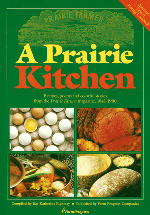I just finished a fascinating little regional cookbook: A Prairie Kitchen: Recipes, Poems, and Colorful Stories from the Prairie Farmer Magazine, 1841-1900, compiled by Iowa cook Rae Katherine Eighmey for the Minnesota Historical Society Press.

I've often wondered about what the original prairie settlers, sod busters, and homesteaders ate, since they obviously had no ice-box (or ice man), stores were a day's travel away, and sugar, molasses, salt, and spices were more expensive than a modern shopper can imagine. This book, culled from the pages of Prairie Farmer—which is still around, by the way—has the answer: corn, mostly. Slap jacks, johnnycake, Indian cake, spoon bread, hominy stew, corn meal mush, fried corn meal mush… whatever form it took, corn seems to have been the quickest, cheapest, most reliable crop, and it kept you alive. Of course, corn also fed chickens, and thus made precious, precious eggs. Fresh milk and butter from the family cow were so important that settlers often lived in one-room cabins with their cows for the first winter; if that cow died, so might they. After that, there were garden vegetables in season, and preserves out of season.
One section of the book reproduces a series of menus, published in 1885, that shows how a family of five might have lived on 15 cents a day. Meat makes an appearance twice in a whole week, as boiling beef one day and as potato stew made from the leftover bones on another. Other than that? Corn, milk, and eggs, then eggs, milk, and corn. All cooked on a potbellied, wood-fired stove. These prairie cooks were truly ingenious, whipping up dishes like cornstarch blancmange, green-corn soup, baked cornmeal pudding with vinegar sauce, and beet pie. Still, to this spoiled 21st-century brat, the experience of living on the prairie seems grimmer and more unrelenting than I really understood until now. Really, just eggs, milk, and corn? Forever?



 Pinterest
Pinterest


